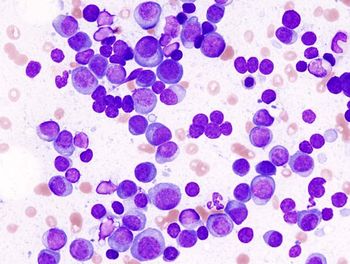
Minimizing Toxicity in NSCLC Management With Proton Beam Radiotherapy
Patients with NSCLC who have comorbidities or frailty may also be able to receive treatment with fewer toxicities via proton beam radiotherapy.
Treatment with proton beam radiotherapy may help treat patients with non–small cell lung cancer (NSCLC) who may not be able to tolerate more intensive courses of chemoradiation, according to Terence T. Sio, MD, MS.
Sio, a professor of radiation oncology at Mayo Clinic in Phoenix, Arizona, spoke with CancerNetwork® about the use of proton beam radiotherapy as a modality that may reduce toxicity during therapy for patients with NSCLC. This treatment may limit the amount of radiation that reaches other organs such as the heart or esophagus, thereby avoiding potential adverse effects that might occur during standard radiotherapy.
According to Sio, proton beam radiotherapy may also demonstrate utility and reduce toxicity in patient subgroups, including those with comorbidities or larger tumors in the lung.
Transcript:
The biggest advantage of proton beam radiotherapy is that the radiation beam will enter one side of the body and hit the tumor [without yielding any] exit radiation at all beyond where the tumor was treated by the proton beam radiotherapy. That means I can decrease the [adverse] effects to the other side of the lung and to the remainder of the same lung. Oftentimes, we have benefits in decreasing the amount of radiation therapy that is going to shoot through the heart or the esophagus with regular radiation therapy.
For conventional radiotherapy, it is often needed to have more beams and different angles to focus and shine in the same tumor and target. The radiation beam cannot stop with x-ray, meaning that with the lung cancer being the target, and with radiation coming in from one side, it still has to treat and kill the tumor. But the radiation therapy beams inevitably have to exit from the other side, and that is where it has the potential of hitting more normal tissues and potentially causing more [adverse] effects.
There's a very strong role of proton beam therapy for our patients who may already not have the best lung functions because of past experience with smoking, our patients who may have more comorbidities and other diseases, [those who] may have had a heart attack before, or [those who] may be older and frailer. We have noticed that, even with patients who have bigger tumors in the lungs, if we can get a very nice proton beam radiotherapy plan, we can help them to go through the treatments better with fewer [adverse] effects or just about the same number of [adverse] effects in otherwise healthier patients [who receive] regular radiation. I think we can be helping some of the patients who otherwise may not be able to stand as intensive of a method of combining radiation and chemotherapy for their lung cancer treatments.
Newsletter
Stay up to date on recent advances in the multidisciplinary approach to cancer.

















































































